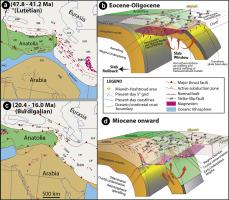当前位置:
X-MOL 学术
›
Gondwana Res.
›
论文详情
Our official English website, www.x-mol.net, welcomes your feedback! (Note: you will need to create a separate account there.)
Long-lived, Eocene-Miocene stationary magmatism in NW Iran along a transform plate boundary
Gondwana Research ( IF 6.1 ) Pub Date : 2020-09-01 , DOI: 10.1016/j.gr.2020.03.014 Ahmad Rabiee , Federico Rossetti , Yoshihiro Asahara , Hossein Azizi , Federico Lucci , Michele Lustrino , Reza Nozaem
Gondwana Research ( IF 6.1 ) Pub Date : 2020-09-01 , DOI: 10.1016/j.gr.2020.03.014 Ahmad Rabiee , Federico Rossetti , Yoshihiro Asahara , Hossein Azizi , Federico Lucci , Michele Lustrino , Reza Nozaem

|
Abstract The Eocene-Miocene Mianeh-Hashtroud igneous district in NW Iran is part of the Turkish–Caucasus–Iranian collision zone, a key region to decipher the assembly and differentiation of Gondwana-derived terranes along the Alpine-Himalayan convergence zone. Major inherited tectonic structures control in space and time the Mesozoic-Cenozoic transition from oceanic subduction to continental collision in the region. The geology of the study area is dominated by a polyphase, long-lived magmatic activity, spanning from ~45 to ~6 Ma. The igneous products are subalkaline to alkaline, with intermediate to acidic compositions and a high-K calcalkaline to shoshonitic affinity. Evidence of crustal contamination is attested by inherited zircons in the oldest (Eocene-Oligocene) samples, with ages spanning from Neo-Archean to Paleocene. The Sr Nd isotopic compositions of the Eocene-Oligocene samples plot close to the Bulk Silicate Earth estimate, whereas the Miocene samples document stronger crustal contamination. The lack of correlation between Nd Sr isotopes and SiO2 supports a scenario of magma differentiation of different magma batches rather than crustal contamination. Major oxide and Sr Nd isotopic variation lead us to suggest that magmatism is the consequence of re-melting of earlier underplated (Mesozoic-Tertiary) magmatic products, controlled by amphibole-dominated fractionation processes. Regional scale correlations show long-lived Cenozoic magmatism in NW Iran and Caucasus region, where the main porphyry and epithermal deposits occur. We propose that the Cenozoic collisional magmatism and the associated mineralisation at the junction between NW-Iran and Caucasus was controlled by the activity of a major, lithosphere-scale inherited boundary, transverse to the convergence zone. In such a geodynamic setting, the along-strike segmentation of the lithosphere slab generated asthenospheric melts, their upwelling into the metasomatised supra-subduction mantle wedge and the potential activation of different mantle and crustal sources, with consequent mineral endowment in the region.
中文翻译:

伊朗西北沿转换板块边界的始新世-中新世长寿命静止岩浆活动
摘要 伊朗西北部始新世-中新世 Mianeh-Hashtroud 火成岩区是土耳其-高加索-伊朗碰撞带的一部分,是破解高山-喜马拉雅辐合带冈瓦纳地体组合和分化的关键区域。主要继承的构造构造在空间和时间上控制了该地区从大洋俯冲到大陆碰撞的中新生代过渡。研究区的地质以多相、长寿命的岩浆活动为主,范围从~45 到~6 Ma。火成产物是亚碱性到碱性,具有中到酸性成分和高 K 钙碱性到钾离子的亲和力。最古老(始新世-渐新世)样品中的继承锆石证明了地壳污染的证据,这些样品的年龄从新太古代到古新世。始新世-渐新世样品的 Sr Nd 同位素组成与大块硅酸盐地球估计值接近,而中新世样品记录了更强的地壳污染。Nd Sr 同位素和 SiO2 之间缺乏相关性支持不同岩浆批次的岩浆分异而不是地壳污染的情景。主要的氧化物和 Sr Nd 同位素变化使我们认为岩浆作用是早期未镀层(中生代-第三纪)岩浆产物重新熔化的结果,受角闪石主导的分馏过程控制。区域尺度相关性显示伊朗西北部和高加索地区的长寿命新生代岩浆活动,主要斑岩和浅成热矿床发生在那里。我们认为,在西北-伊朗和高加索交界处的新生代碰撞岩浆活动和相关的矿化受主要的岩石圈尺度继承边界的活动控制,该边界与辐合带横向。在这样的地球动力学环境中,岩石圈板块的沿走向分割产生了软流圈熔体,它们上涌到交代的超俯冲地幔楔中,并可能激活不同的地幔和地壳来源,从而导致该地区的矿物资源丰富。
更新日期:2020-09-01
中文翻译:

伊朗西北沿转换板块边界的始新世-中新世长寿命静止岩浆活动
摘要 伊朗西北部始新世-中新世 Mianeh-Hashtroud 火成岩区是土耳其-高加索-伊朗碰撞带的一部分,是破解高山-喜马拉雅辐合带冈瓦纳地体组合和分化的关键区域。主要继承的构造构造在空间和时间上控制了该地区从大洋俯冲到大陆碰撞的中新生代过渡。研究区的地质以多相、长寿命的岩浆活动为主,范围从~45 到~6 Ma。火成产物是亚碱性到碱性,具有中到酸性成分和高 K 钙碱性到钾离子的亲和力。最古老(始新世-渐新世)样品中的继承锆石证明了地壳污染的证据,这些样品的年龄从新太古代到古新世。始新世-渐新世样品的 Sr Nd 同位素组成与大块硅酸盐地球估计值接近,而中新世样品记录了更强的地壳污染。Nd Sr 同位素和 SiO2 之间缺乏相关性支持不同岩浆批次的岩浆分异而不是地壳污染的情景。主要的氧化物和 Sr Nd 同位素变化使我们认为岩浆作用是早期未镀层(中生代-第三纪)岩浆产物重新熔化的结果,受角闪石主导的分馏过程控制。区域尺度相关性显示伊朗西北部和高加索地区的长寿命新生代岩浆活动,主要斑岩和浅成热矿床发生在那里。我们认为,在西北-伊朗和高加索交界处的新生代碰撞岩浆活动和相关的矿化受主要的岩石圈尺度继承边界的活动控制,该边界与辐合带横向。在这样的地球动力学环境中,岩石圈板块的沿走向分割产生了软流圈熔体,它们上涌到交代的超俯冲地幔楔中,并可能激活不同的地幔和地壳来源,从而导致该地区的矿物资源丰富。



























 京公网安备 11010802027423号
京公网安备 11010802027423号